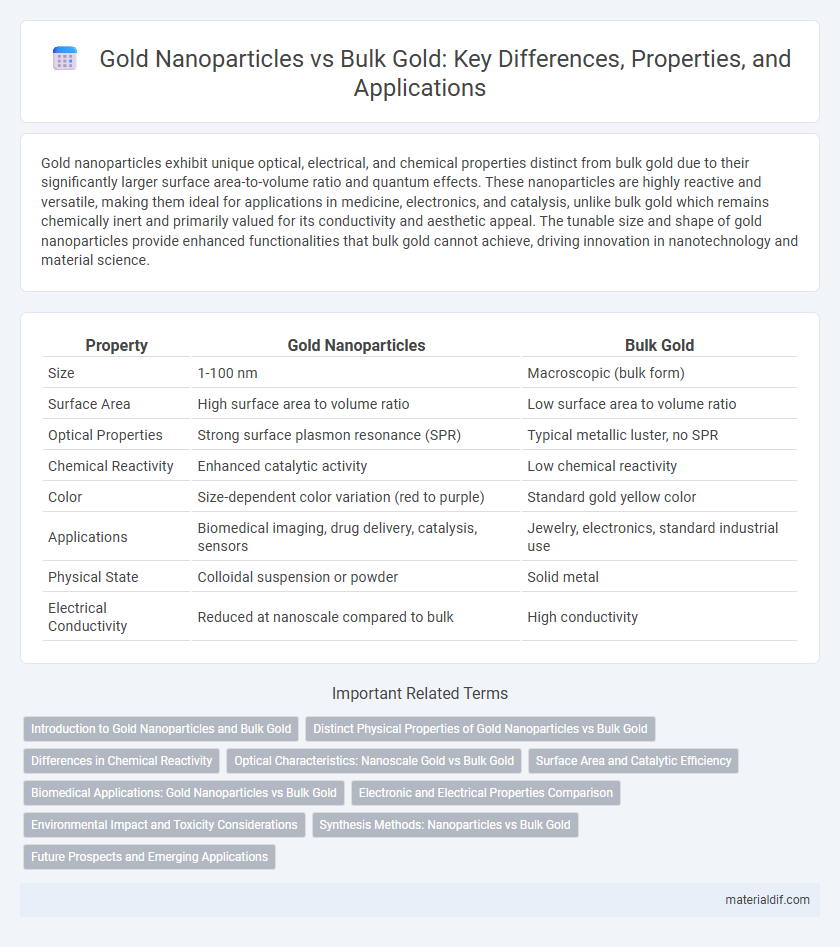Gold nanoparticles exhibit unique optical, electrical, and chemical properties distinct from bulk gold due to their significantly larger surface area-to-volume ratio and quantum effects. These nanoparticles are highly reactive and versatile, making them ideal for applications in medicine, electronics, and catalysis, unlike bulk gold which remains chemically inert and primarily valued for its conductivity and aesthetic appeal. The tunable size and shape of gold nanoparticles provide enhanced functionalities that bulk gold cannot achieve, driving innovation in nanotechnology and material science.
Table of Comparison
| Property | Gold Nanoparticles | Bulk Gold |
|---|---|---|
| Size | 1-100 nm | Macroscopic (bulk form) |
| Surface Area | High surface area to volume ratio | Low surface area to volume ratio |
| Optical Properties | Strong surface plasmon resonance (SPR) | Typical metallic luster, no SPR |
| Chemical Reactivity | Enhanced catalytic activity | Low chemical reactivity |
| Color | Size-dependent color variation (red to purple) | Standard gold yellow color |
| Applications | Biomedical imaging, drug delivery, catalysis, sensors | Jewelry, electronics, standard industrial use |
| Physical State | Colloidal suspension or powder | Solid metal |
| Electrical Conductivity | Reduced at nanoscale compared to bulk | High conductivity |
Introduction to Gold Nanoparticles and Bulk Gold
Gold nanoparticles exhibit unique optical, electronic, and chemical properties distinct from bulk gold due to their nanoscale size and high surface area-to-volume ratio. Unlike bulk gold, which is valued primarily for its conductivity, malleability, and resistance to corrosion, gold nanoparticles are utilized in biomedical imaging, drug delivery, and catalytic applications. The quantum size effects in gold nanoparticles lead to tunable surface plasmon resonance, enabling enhanced reactivity and functionality compared to traditional bulk gold forms.
Distinct Physical Properties of Gold Nanoparticles vs Bulk Gold
Gold nanoparticles exhibit unique optical properties such as surface plasmon resonance, which causes intense colors and enhanced light absorption not present in bulk gold. Their high surface-to-volume ratio leads to increased chemical reactivity and catalytic activity compared to the inert bulk gold. Additionally, gold nanoparticles display size-dependent melting points and conductivity variations, contrasting with the consistent physical characteristics of bulk gold.
Differences in Chemical Reactivity
Gold nanoparticles exhibit significantly higher chemical reactivity compared to bulk gold due to their increased surface-to-volume ratio and quantum size effects. This enhanced reactivity enables gold nanoparticles to act as efficient catalysts in various chemical reactions, such as oxidation and reduction processes, where bulk gold remains largely inert. Surface atoms in nanoparticles have unsaturated coordination sites, leading to unique electronic properties that facilitate stronger interactions with reactants.
Optical Characteristics: Nanoscale Gold vs Bulk Gold
Gold nanoparticles exhibit unique optical properties due to localized surface plasmon resonance (LSPR), resulting in vibrant colors that vary with particle size and shape, unlike bulk gold which has a uniform metallic yellow appearance. These nanoscale gold particles absorb and scatter light differently, enabling applications in bioimaging, sensing, and photothermal therapy that bulk gold cannot achieve. The tunable optical response of gold nanoparticles arises from quantum size effects and enhanced surface area, providing significant advantages in nanotechnology and material science.
Surface Area and Catalytic Efficiency
Gold nanoparticles exhibit a significantly higher surface area-to-volume ratio compared to bulk gold, which enhances their catalytic efficiency in various chemical reactions. The increased surface area allows more active sites for reactant interaction, making gold nanoparticles highly effective catalysts in oxidation and reduction processes. This superior catalytic performance is crucial in applications such as environmental remediation and chemical synthesis, where nanoscale gold outperforms bulk material.
Biomedical Applications: Gold Nanoparticles vs Bulk Gold
Gold nanoparticles exhibit unique physicochemical properties such as high surface area-to-volume ratio and enhanced biocompatibility, making them more effective than bulk gold in biomedical applications like drug delivery, imaging, and diagnostics. Their ability to functionalize with various biomolecules allows targeted therapy and improved cellular uptake compared to bulk gold, which lacks these nanoscale advantages. Furthermore, gold nanoparticles demonstrate superior optical properties, enabling sensitive detection in biosensing and photothermal therapies not achievable with bulk gold.
Electronic and Electrical Properties Comparison
Gold nanoparticles exhibit distinct electronic and electrical properties compared to bulk gold due to quantum size effects and increased surface-to-volume ratio, resulting in altered conductivity and electron mobility. Unlike bulk gold, which has a uniform electron density and well-defined conduction bands, gold nanoparticles demonstrate discrete energy levels and enhanced electron scattering at surfaces. These variations make gold nanoparticles highly suitable for applications in nanoelectronics and sensors where tunable electrical conductivity is essential.
Environmental Impact and Toxicity Considerations
Gold nanoparticles exhibit distinct environmental impact and toxicity profiles compared to bulk gold due to their increased surface area and reactivity, which enhance interactions with biological systems and ecosystems. Studies indicate that gold nanoparticles can induce oxidative stress and bioaccumulation in aquatic organisms, raising concerns about their potential toxicity and environmental persistence. In contrast, bulk gold shows minimal toxicity and environmental risk due to its inert nature and low solubility, making nanoscale gold a critical focus for environmental safety assessments and regulatory guidelines.
Synthesis Methods: Nanoparticles vs Bulk Gold
Gold nanoparticles are synthesized using chemical reduction, physical vapor deposition, or biological methods, allowing precise control over particle size and shape at the nanoscale. Bulk gold is typically produced through large-scale metallurgical processes such as smelting and refining of gold ore, which do not allow manipulation at the nanoscale. The synthesis of gold nanoparticles requires specialized techniques like citrate reduction and seed-mediated growth to achieve unique optical and catalytic properties distinct from bulk gold.
Future Prospects and Emerging Applications
Gold nanoparticles exhibit unique optical, electronic, and chemical properties that enable transformative applications in biomedicine, electronics, and catalysis, setting them apart from bulk gold. Emerging uses include targeted drug delivery, enhanced diagnostic imaging, and highly efficient catalysts for green chemistry, driven by their high surface-area-to-volume ratio and tunable surface chemistry. Future prospects emphasize integrating gold nanoparticles in quantum computing, photothermal therapies, and environmental remediation, highlighting their potential to revolutionize multiple high-tech industries.
Gold Nanoparticles vs Bulk Gold Infographic

 materialdif.com
materialdif.com